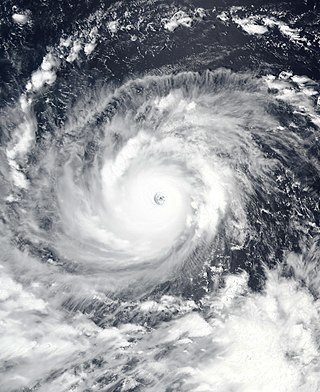
A typhoon is a tropical cyclone that develops between 180° and 100°E in the Northern Hemisphere and which produces sustained hurricane-force winds of at least 119 km/h (74 mph). This region is referred to as the Northwestern Pacific Basin, accounting for almost one third of the world's tropical cyclones. The term hurricane refers to a tropical cyclone in the north central and northeast Pacific, and the north Atlantic. In all of the preceding regions, weaker tropical cyclones are called tropical storms. For organizational purposes, the northern Pacific Ocean is divided into three regions: the eastern, central, and western. The Regional Specialized Meteorological Center (RSMC) for tropical cyclone forecasts is in Japan, with other tropical cyclone warning centres for the northwest Pacific in Hawaii, the Philippines, and Hong Kong. Although the RSMC names each system, the main name list itself is coordinated among 18 countries that have territories threatened by typhoons each year.

The 2016 Pacific typhoon season is considered to have been the fourth-latest start for a Pacific typhoon season since reliable records began. It was an average season, with a total of 26 named storms, 13 typhoons, and six super typhoons. The season ran throughout 2016, though typically most tropical cyclones develop between May and October. The season's first named storm, Nepartak, developed on July 3, while the season's last named storm, Nock-ten, dissipated on December 28.
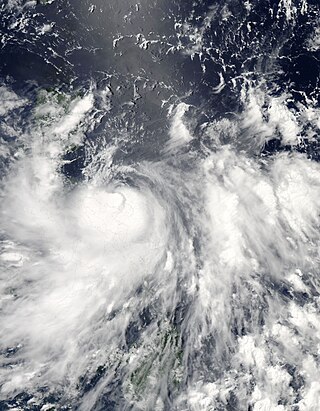
Typhoon Conson, known in the Philippines as Typhoon Basyang, was the second tropical cyclone during the 2010 Pacific typhoon season to impact the Philippines. Developing out of a tropical disturbance east of the Philippines on July 11, 2010, Conson quickly developed as it tracked nearly due west. Favorable environmental conditions, such as low wind shear and warm sea surface temperatures, allowed the system to intensify into a severe tropical storm by July 12. Around the same time, the JTWC assessed the storm to have been equivalent to a Category 1 hurricane. The following day, Conson struck Quezon Province with winds of 100 km/h (60 mph) before weakening. After crossing the archipelago, the storm entered the South China Sea where it was able to re-strengthen. By July 16, Conson attained typhoon status as it neared the southern Chinese island of Hainan. After brushing the island at peak intensity with sustained winds estimated at 130 km/h (80 mph), the storm weakened in the Gulf of Tonkin due to less favorable conditions. The storm eventually made landfall near Hanoi, Vietnam on July 17 and dissipated the following day.

Typhoon Nesat, known in the Philippines as Typhoon Pedring, was the most powerful tropical cyclone to directly impact China since 2005. It also struck the Philippines during the 2011 Pacific typhoon season, killing 98 people. It is the 17th named storm, the 11th severe tropical storm, the 7th typhoon and overall, the 30th tropical cyclone to be monitored by the Japan Meteorological Agency(JMA) during the year. Nesat came exactly two years after Typhoon Ketsana made landfall in the Philippines as the most devastating typhoon in the 2009 Pacific typhoon season with a damage of US$1.09 billion and 747 fatalities. Nesat was also the first of twin tropical cyclones to batter the Philippines within one week during September 2011, the second was Nalgae.

Typhoon Son-Tinh, known in the Philippines as Tropical Storm Ofel, was a powerful, late-forming typhoon that devastated the Philippines with tropical storm strength, and battered Northern Vietnam with hurricane-force winds at landfall on October 28, 2012. Originating from a broad area of low pressure over Palau on October 20, the system strengthened into a tropical depression by October 21, and on October 22, it became the 23rd named storm of the season.
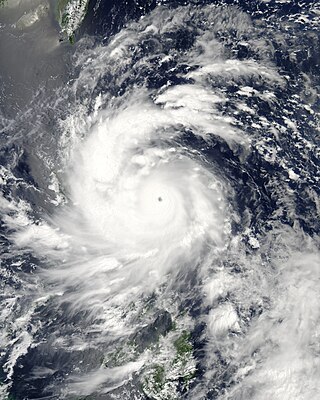
Typhoon Utor, known in the Philippines as Super Typhoon Labuyo, was a powerful, deadly and destructive tropical cyclone that struck the Philippines and southern China. Utor, contributed by United States for squall line, the 15th depression, the 2nd typhoon and the first super typhoon in the 2013 Pacific typhoon season. Utor started originating near Yap, tracking westwards in a favorable development, allowing the system to be better organized. All agencies have upgraded the system as a depression, with JTWC designated as Tropical Depression 11W and PAGASA naming the depression as Labuyo. Continuing westwards, JMA named 11W as Utor as it continues to consolidate.

Typhoon Usagi, known in the Philippines as Super Typhoon Odette, was a violent tropical cyclone which affected Taiwan, the Philippines, China, and Hong Kong in September 2013. Usagi, or which means the constellation Lepus in Japanese, was the fourth typhoon and the nineteenth tropical storm in the basin. Developing into a tropical storm east of the Philippines late on September 16, Usagi began explosive intensification on September 19 and ultimately became a violent and large typhoon. Afterwards, the system weakened slowly, crossed the Bashi Channel on September 21, and made landfall over Guangdong, China on September 22.
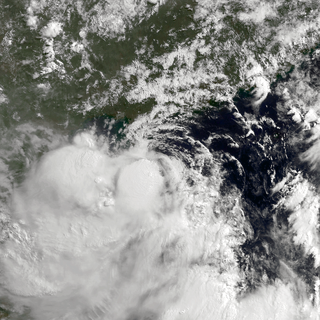
Tropical Storm Bebinca, known in the Philippines as Tropical Depression Fabian, was a weak tropical cyclone that brought minor damage in China and Vietnam, causing a death and an economic loss of about US$13 million. The sixth depression and fifth named storm of the season. Bebinca originated as a low-pressure area south of Hong Kong. As the disturbance is moving westward, favorable conditions allow the system to organize into a tropical depression. On June 21, the depression was upgraded into a tropical storm despite the wind shear, which generated by a subtropical ridge.

Typhoon Rammasun, known in the Philippines as Typhoon Glenda, was one of the only three Category 5 super typhoons on record in the South China Sea, with the other ones being Pamela in 1954 and Rai in 2021. Rammasun had destructive impacts across the Philippines, South China, and Vietnam in July 2014. Rammasun is a Siamese word for thunder god. After Lingling and Kajiki earlier in 2014, Rammasun became the third tropical cyclone, and first typhoon to directly impact the Philippines in 2014. The ninth named storm and the third typhoon of the annual typhoon season, Rammasun formed in the Intertropical Convergence Zone, an area near the equator where the northeast and southeast trade winds come together, and slowly drifted northwest. Having passed through the islands of Micronesia, the system turned west and quickly moved under the influence of a subtropical ridge (STR). Rammasun posed a significant threat to the Philippine island of Luzon, as it was expected to reach typhoon intensity before making landfall there. Though initially forecast to make landfall in Cagayan Valley, the storm followed a more westerly path and was later forecast to make landfall in Rapu-Rapu, Albay in Bicol Region and then pass through Bataan and Zambales before brushing past Metro Manila.
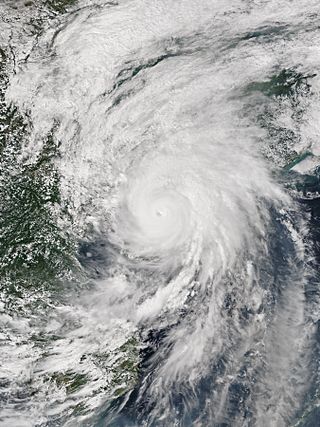
Typhoon Mujigae, known in the Philippines as Tropical Storm Kabayan, was the costliest typhoon to impact China in 2015. The typhoon first passed over the Philippines as a developing tropical cyclone from October 1 to 3, 2015. It then caused widespread damage in the Chinese provinces of Guangdong, Guangxi, and Hainan from October 3 to 6. Afterwards, as Mujigae weakened inland, it brought heavy rain to parts of Mainland Southeast Asia. Mujigae originated from an area of disturbed weather that formed just east of the Philippines on September 30. The disturbance slowly organized amid a favorable environment, becoming a tropical depression later that day. It traveled steadily west-northwestwards and made landfall in Central Luzon late on October 1, before crossing into the South China Sea the next morning. Mujigae strengthened rapidly on October 3, becoming a mature typhoon with 10-minute sustained winds of 155 km/h (96 mph), 1-minute sustained winds of 215 km/h (134 mph), and a minimum pressure of 950 hPa (28.05 inHg). The typhoon then made landfall over Zhanjiang, Guangdong, and weakened swiftly, dissipating inland over Guangxi on October 5.

Typhoon Meranti, known in the Philippines as Super Typhoon Ferdie, was one of the most intense tropical cyclones on record. Impacting the Batanes in the Philippines, Taiwan, as well as Fujian Province in September 2016, Meranti formed as a tropical depression on September 8 near the island of Guam. Tracking to the west northwest, Meranti gradually intensified until September 11, at which point it began a period of rapid intensification. Continuing to rapidly intensify, it became a super typhoon early on September 12, as it passed through the Luzon Strait, ultimately reaching its peak intensity on September 13 with 1-minute sustained winds of 315 km/h (195 mph). Shortly afterwards, it passed directly over the island of Itbayat. Meranti passed to the south of Taiwan as a super typhoon, and began weakening steadily as a result of land interaction. By September 15, it struck Fujian Province as a Category 2-equivalent typhoon, becoming the strongest typhoon on record to impact the province. Upon moving inland, rapid weakening ensued and Meranti became extratropical the next day, dissipating shortly afterwards after it passed to the south of the Korean Peninsula.

Typhoon Haima, known in the Philippines as Super Typhoon Lawin, was the third most intense tropical cyclone worldwide in 2016. It was the twenty-second named storm and the eleventh typhoon of the annual typhoon season. Impacting the Philippines less than 3 days after Typhoon Sarika, Haima formed out of a tropical disturbance southwest of Chuuk on October 14, it developed into a tropical storm the next day. Steady strengthening occurred over the next day or two as it tracked westward towards the Philippines. After forming an eye shortly after it was upgraded to a typhoon, Haima began to rapidly strengthen and eventually became a super typhoon on October 18. It later attained its peak intensity as a Category 5-equivalent tropical cyclone before weakening slightly. Haima later made landfall in Peñablanca, Cagayan late on October 19 as a Category 4-equivalent storm. Rapid weakening occurred as it interacted with the landmasses until it entered the Southern China Sea as a weak typhoon. It formed a large ragged eye once again and remained steady in intensity until making landfall in China on October 21. It weakened below typhoon intensity and became extratropical on October 22. The cyclone drifted northeastwards and later eastwards before emerging over water again, but eventually dissipated by October 26.

Typhoon Mangkhut, known in the Philippines as Super Typhoon Ompong, was a powerful and catastrophic Category 5 tropical cyclone that caused extensive damage in Guam, the Philippines and South China in September 2018. It was the strongest typhoon to strike Luzon since Megi in 2010, and the strongest to make landfall anywhere in the Philippines since Meranti in 2016. Mangkhut was also the strongest typhoon to affect Hong Kong since Ellen in 1983.
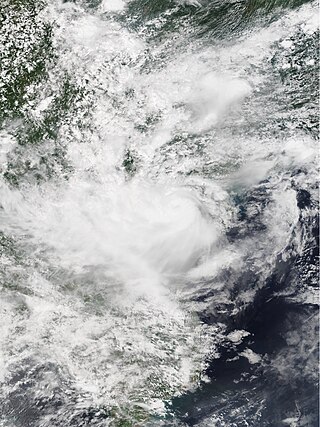
Tropical Storm Bebinca was a weak but erratic and long-lived tropical cyclone that affected South China and Vietnam in mid-August 2018. Bebinca originated from a tropical depression over the South China Sea on August 9. Maintaining this intensity for a few days near the Guangdong coast, the system intensified into a tropical storm south of Jiangmen on August 13. The storm moved slowly to the east and then curved back on the next day, before making landfall in the Leizhou Peninsula on August 15. Bebinca crossed the Gulf of Tonkin and made landfall in Vietnam on August 16, before dissipated on the next day.
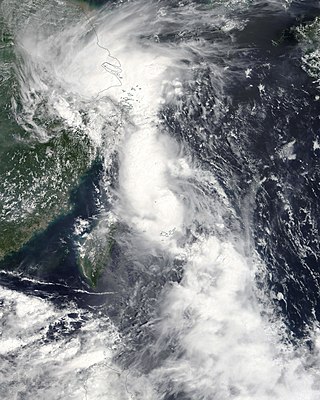
Tropical Storm Yagi, known in the Philippines as Tropical Storm Karding, was a moderate but damaging tropical cyclone that impacted the Philippines from enhanced southwest monsoon and China. The fourteen named storm of the 2018 Pacific typhoon season. Yagi started its lifetime as an area of low-pressure, located southwest of Iwo To on August 1. The system struggled to intensify for five days until it was recognized as a depression by the JMA on August 7. JTWC later followed suit and went ahead to designate it as Tropical Depression 18W. It maintained its intensity due to easterly wind shear, despite the system being well organized. Both agencies upgraded into a tropical storm on the next day after showing winds of 35 knots.
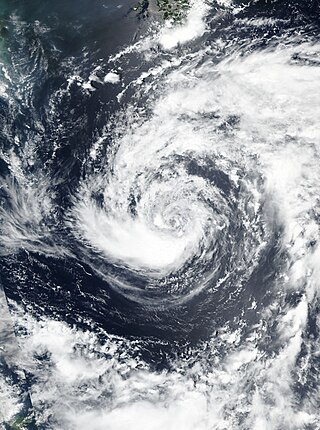
Severe Tropical Storm Ampil, known in the Philippines as Severe Tropical Storm Inday, was a tropical cyclone that caused moderate damage in the Ryukyu Islands and East and Northeast China in late July 2018. The tenth named storm of the annual typhoon season, Ampil developed into a tropical depression east of Luzon on July 17. The system gradually strengthened over the following days amid a marginally favorable environment and became a severe tropical storm late on July 19 as it moved northwest. Maintaining its strength, Ampil passed over Okinawa Island from July 20 to 21. Thereafter, Ampil weakened slightly while crossing the East China Sea, before making landfall in Shanghai, China, on July 22. The system weakened slowly over land and degraded to a tropical depression on July 23. The system turned eastwards as it continued weakening over land, diminishing to a remnant low on July 25 and dissipating fully a day later over the Russian Far East.
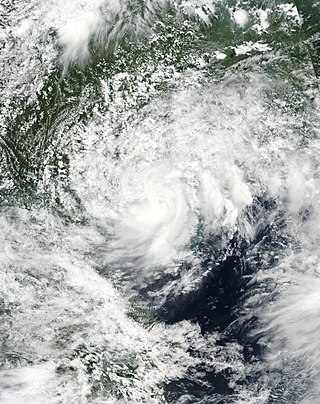
Tropical Storm Wipha was a tropical cyclone that caused significant damages in Vietnam and China. Wipha was the eleventh depression, and the ninth tropical storm of the 2019 Pacific typhoon season.

Tropical Storm Lionrock, known in the Philippines as Tropical Depression Lannie, was a tropical storm which caused minor damage to the Philippines, Vietnam, and Hainan. Lionrock was the 17th named storm of the 2021 Pacific typhoon season. Six people perished due to the storm: three in the Philippines, two in Vietnam, and one in Hong Kong. According to Aon Benfield, economic losses totaled US$47 million. Tropical Storm Kompasu affected many areas, previously impacted by Lionrock, only a few days later.

Severe Tropical Storm Kompasu, known in the Philippines as Severe Tropical Storm Maring was a very large and deadly tropical cyclone that affected the Philippines, Taiwan, and southeast China. Part of the 2021 Pacific typhoon season, Kompasu originated from an area of low pressure east of the Philippines on 6 October 2021. The Japan Meteorological Agency (JMA) classified it as a tropical depression that day. A day later, the Philippine Atmospheric, Geophysical and Astronomical Services Administration (PAGASA) classified it as a tropical depression, naming it Maring. The cyclone was initially heavily disorganised, competing with another vortex, Tropical Depression Nando. Eventually, Maring became dominant, and the JMA reclassified it as a tropical storm, naming it Kompasu. Kompasu made landfall in Cagayan, Philippines, on 11 October 2021, and two days later, the storm made landfall in Hainan, China. The cyclone dissipated on 14 October 2021 while located over Vietnam.

























